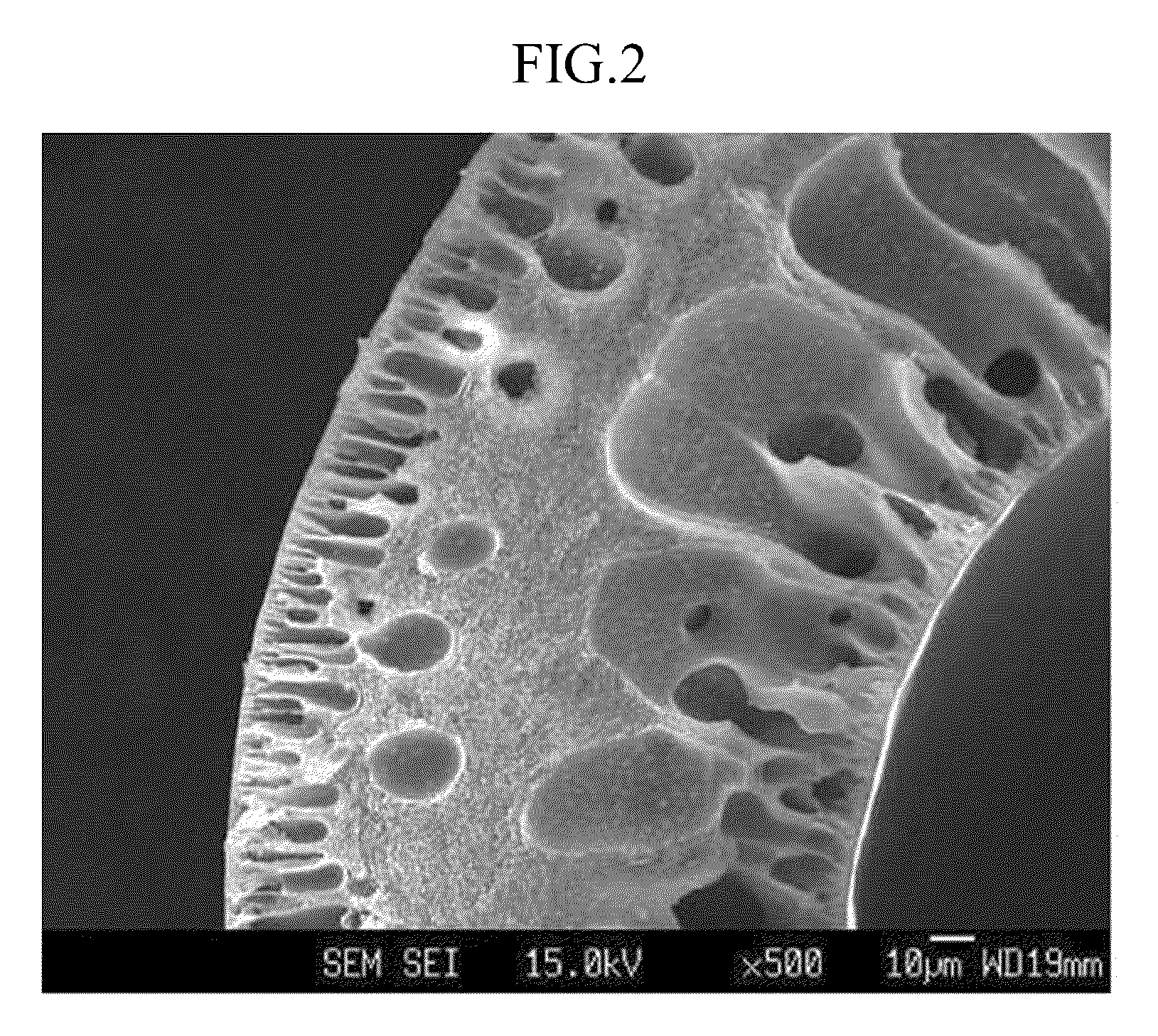Hollow fiber, dope composition for forming hollow fiber, and method of preparing hollow fiber using the same
a technology of hollow fiber and dope solution, which is applied in the field of hollow fiber, can solve the problems of limited number of gas separation methods, difficult to obtain separation and permeation capabilities beyond a predetermined upperbound, and relatively short history of gas separation using the membrane process. , to achieve the effect of excellent gas permeability, good endurance, and good mechanical strength and chemical stability
- Summary
- Abstract
- Description
- Claims
- Application Information
AI Technical Summary
Benefits of technology
Problems solved by technology
Method used
Image
Examples
example 1
[0198]A hollow fiber including polybenzoxazole represented by Chemical Formula 51 was prepared using the polyhydroxyamic acid-containing dope solution composition for forming a hollow fiber through the following Reaction Scheme 3.
[0199](1) Preparation of Polyhydroxyamic Acid
[0200]36.6 g (0.1 mol) of 2,2-bis(3-amino-4-hydroxyphenyl) hexafluoropropane and 44.4 g (0.1 mol) of 4,4′-(hexafluoroisoproylidene)diphthalic anhydride was added into 189 g (70 wt %) of N-methylpyrrolidone (NMP) and then reacted at 15° C. for 4 hours to obtain a pale yellow Viscous polyamic acid.
[0201](2) Preparation of a Dope Solution Composition for Forming a Hollow Fiber
[0202]The resulting polyamic acid was added to 5 wt % of tetrahydrofuran as an additive without removal of the solvent to prepare a homogeneous dope solution composition for forming a hollow fiber.
[0203](3) Preparation of Hollow Fiber
[0204]The dope solution composition for forming a hollow fiber was defoamed at ambient temperature under reduced...
example 2
[0206]A hollow fiber including polybenzothiazole represented by Chemical Formula 52 was prepared using the polythioamic acid-containing dope solution composition for forming a hollow fiber through the following reaction.
[0207]A hollow fiber including polybenzothiazole represented by the above Chemical Formula 52 was prepared in the same manner as in Example 1, except that for starting materials, 20.8 g (0.1 mol) of 2,5-diamino-1,4-benzenedithiol dihydrochloride and 44.4 g (0.1 mol) of 4,4′-(hexafluoroisoproylidene)diphthalic anhydride were reacted to prepare polyamic acid including a thiol group (—SH).
[0208]The hollow fiber thus prepared had a weight average molecular weight of 14,500. As a result of FT-IR analysis, characteristic bands of polybenzothiazole at 1484 cm−1(C—S) and 1404 cm−1(C—S) which were not detected in polyimide. The hollow fiber has a fractional free volume of 0.26, and interplanar distance (d-spacing) of 610 pm. The interplanar distance (d-spacing) was measured b...
example 3
[0209]A hollow fiber including polypyrrolone represented by Chemical Formula 53 was prepared using the polyaminoamic acid-containing dope solution composition for forming a hollow fiber through the following reaction.
[0210]A hollow fiber including polypyrrolone represented by the above Chemical Formula 53 was prepared in the same manner as in Example 1, except that for starting materials, 21.4 g (0.1 mol) of 3,3′-diaminobenzidine and 44.4 g (0.1 mol) of 4,4′-(hexafluoroisoproylidene)diphthalic anhydride were reacted to prepare polyamic acid including an amine group (—NH2).
[0211]The hollow fiber thus prepared had a weight average molecular weight of 18,000. As a result of FT-IR analysis, characteristic bands of polypyrrolone at 1758 cm−1(C═O) and 1625 cm−1(C═N) which were not detected in polyimide. The hollow fiber has a fractional free volume of 0.28, and interplanar distance (d-spacing) of 630 pm. The interplanar distance (d-spacing) was measured by X-ray diffraction (XRD, CuKα ray...
PUM
| Property | Measurement | Unit |
|---|---|---|
| interplanar distance | aaaaa | aaaaa |
| FWHM | aaaaa | aaaaa |
| viscosity | aaaaa | aaaaa |
Abstract
Description
Claims
Application Information
 Login to View More
Login to View More - R&D
- Intellectual Property
- Life Sciences
- Materials
- Tech Scout
- Unparalleled Data Quality
- Higher Quality Content
- 60% Fewer Hallucinations
Browse by: Latest US Patents, China's latest patents, Technical Efficacy Thesaurus, Application Domain, Technology Topic, Popular Technical Reports.
© 2025 PatSnap. All rights reserved.Legal|Privacy policy|Modern Slavery Act Transparency Statement|Sitemap|About US| Contact US: help@patsnap.com



